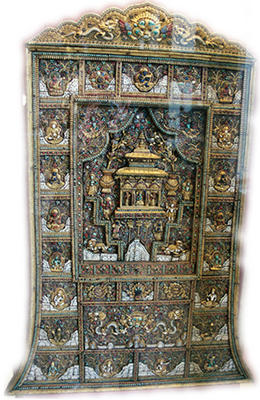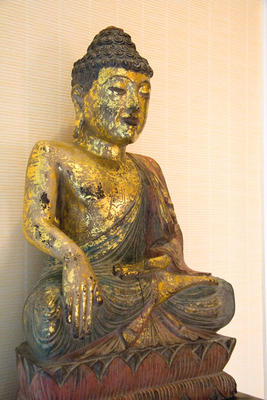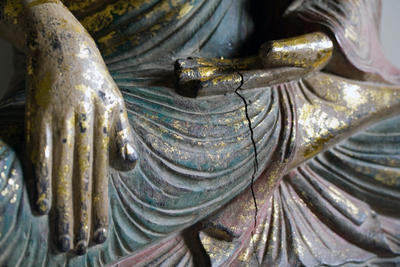The 4 truths of the Buddha
 British Museum, Asian Section, Canon EOS 500N
British Museum, Asian Section, Canon EOS 500N1. there is inevitable suffering
2. there are causes to this suffering, and an account of those causes
3. there is a remedy to end suffering
4. there is a path to follow to achieve freedom from suffering
this path is frequently formulated as moral conduct, meditation and wisdom.
 Canon EOS 350D, EFS 17-85mm, 33mm, f/5, 1/40 sec, 1600 ISO, RAW format
Canon EOS 350D, EFS 17-85mm, 33mm, f/5, 1/40 sec, 1600 ISO, RAW formatSymbolic gestures (Mudras)
Many hand positions were used in Buddhist sculpture and painting to indicate to the faithful in a simple way the nature and the function of the deities represented.
These mudras are gestures which symbolize forces or divine manifestations.

Canon EOS 350D, EFS 60mm, f/4.5, 1/160 sec, 800 ISO, RAW format
The Bhumisparsa mudra
This mudra, litteraly the gesture of touching the earth, portrays the Buddha taking the earth as witness. It describes the moment in the life of the Buddha Gautama when, armed with his resolve to remain seated under the pipal tree at Bodh-Gaya until he had solved the problem of the cessation of suffering, he took the earth as testimony of the merits that he had accumulated during his previous incarnations.
It's hence the symbol of unshakeable faith and resolution.
With the Buddha represented seated in the lotus position (Padmasana), the right hand touches the ground with the finger tips near the right knee, all the fingers extended, or only with the tip of the forefinger, while the left hand rests, palm upward, in the hollow of the thighs.

Canon EOS 350D, EFS 60mm, f/4, 1/125 sec, 800 ISO, RAW format
All extracts are from Buddhism, Flammarion Iconographic Guides, Louis Frederic (Ed. Flammarion)


Comments